How to Grow Lemon Cypress Tree
- March 22, 2024
- 0 comment
Learn how to grow Lemon Cypress tree (Cupressus macrocarpa ‘Goldcrest’) with our guide. Discover tips for vibrant foliage and a refreshing lemony scent. These small evergreen trees, scientifically known as Cupressus macrocarpa ‘Goldcrest,’ are popular for their striking appearance and easy maintenance. Whether you’re a seasoned gardener or just starting out, growing a lemon cypress tree can be a rewarding experience. Here’s a comprehensive guide on how to grow and care for these beautiful trees.
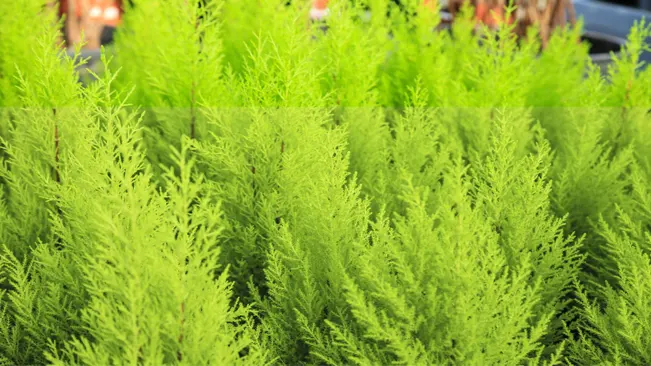
Characteristics of Cypress Tree
| Feature | Description |
|---|---|
| Scientific Name | Cupressus macrocarpa ‘Goldcrest’ |
| Common Name | Lemon Cypress Tree |
| Foliage Color | Vibrant yellow-green |
| Foliage Scent | Lemon-scented needles |
| Growth Habit | Pyramidal or columnar shape |
| Height at Maturity | 6-8 feet (when planted in the ground) |
| Hardiness Zones | USDA zones 7-10 |
| Sunlight Requirement | Full sunlight (6-8 hours per day) |
| Soil Preference | Well-draining soil |
| Watering Needs | Moderate; keep soil slightly moist, avoid waterlogging |
| Fertilization Needs | Regular feeding during growing season with balanced, slow-release fertilizer |
| Pruning Requirements | Minimal; pruning for shaping or removing dead/damaged branches |
| Pest Resistance | Generally resistant; occasional infestations of aphids, spider mites, or scale insects may occur |
| Indoor Suitability | Can be grown indoors with adequate sunlight |
| Toxicity | Not toxic to pets, but ingestion may cause mild gastrointestinal upset |
Table of Contents
- Selecting the Right Location
- Planting
- Watering
- Fertilization
- Pruning and Shaping
- Pest and Disease Control
- Winter Care
- Container Care
Selecting the Right Location
Before you start growing a lemon cypress tree, it’s essential to choose the right location. Lemon cypresses thrive in full sun to partial shade, so look for a spot in your garden or indoor space that receives ample sunlight. If you’re planting outdoors, ensure the soil is well-draining to prevent waterlogging, as lemon cypresses prefer slightly acidic to neutral soil pH.
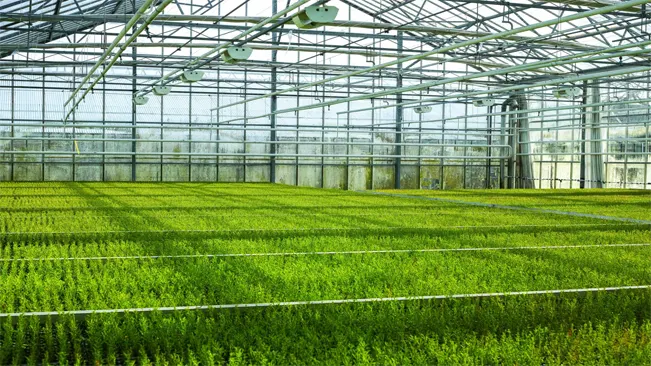
Sunlight Exposure
- Lemon cypress trees thrive in full sun to partial shade. Choose a location that receives at least 6-8 hours of sunlight per day for optimal growth and vibrant foliage color.
Soil Drainage
- Ensure the soil in your chosen location is well-draining. Lemon cypresses do not tolerate waterlogged soil, which can lead to root rot and other issues. Test the soil drainage by digging a hole and filling it with water. If the water drains away within a few hours, the soil is suitable.
Soil pH
- Lemon cypress trees prefer slightly acidic to neutral soil pH levels. Aim for a pH range between 6.0 and 7.0 for optimal growth. You can test the soil pH using a home testing kit or by sending a sample to a local agricultural extension office for analysis.
Protection from Harsh Conditions
- While lemon cypress trees are generally hardy, they may benefit from some protection against harsh environmental conditions. Choose a location that is sheltered from strong winds, especially if you live in an area prone to gusty conditions.
Space Requirements
- Consider the mature size of the lemon cypress tree when selecting a location. These trees can reach heights of 6-8 feet when planted in the ground, so ensure there is enough space for the tree to grow without obstruction.
Indoor vs. Outdoor Growing
- Lemon cypress trees can be grown both indoors and outdoors. If growing indoors, place the tree near a south-facing window where it can receive ample sunlight. Outdoors, select a spot that provides the necessary sunlight exposure and meets the other requirements mentioned above.
Planting
When planting a Lemon Cypress Tree, whether in a container or in the ground, proper preparation and care are essential for its long-term health and growth.
Container Planting

- If planting in a container, select a pot that is large enough to accommodate the root ball of the tree and has drainage holes at the bottom. This ensures that excess water can drain freely, preventing waterlogging which can lead to root rot.
- Choose a high-quality potting mix specifically formulated for container plants. This mix should provide good drainage while retaining enough moisture for the roots to access.
- Place the Lemon Cypress Tree in the center of the pot and fill it with potting mix, ensuring that the tree is planted at the same depth it was in the nursery container. Gently pat down the soil around the base of the tree to secure it in place.
Planting in the Ground
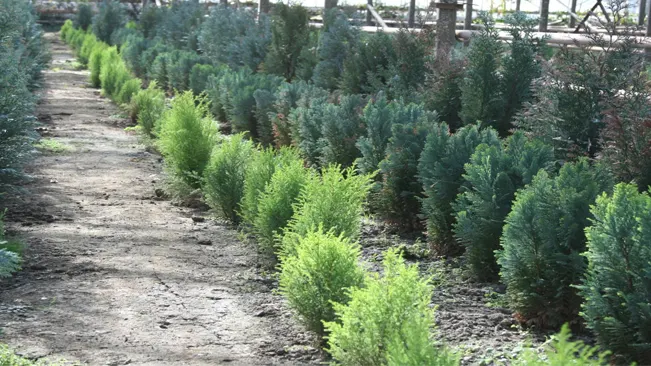
- When planting directly in the ground, select a location that receives full sunlight for at least 6-8 hours per day. Ensure that the soil is well-draining to prevent waterlogged conditions.
- Dig a hole slightly larger than the root ball of the Lemon Cypress Tree. Loosen the soil in the hole and amend it with organic matter if necessary to improve drainage and fertility.
- Carefully remove the tree from its nursery container, taking care not to disturb the roots excessively. Place the tree in the center of the hole and backfill with soil, gently firming it down around the base of the tree.
- Water the newly planted tree thoroughly to settle the soil and encourage root establishment. Maintain regular watering throughout the growing season, especially during dry periods.
Aftercare
- Regardless of whether the Lemon Cypress Tree is planted in a container or in the ground, proper aftercare is crucial for its establishment and growth.
- Monitor the soil moisture regularly, ensuring that it remains slightly moist but not waterlogged. Adjust watering frequency based on weather conditions and the moisture level of the soil.
- Apply a layer of organic mulch around the base of the tree to conserve soil moisture, suppress weed growth, and provide insulation against temperature fluctuations.
- Protect the tree from extreme weather conditions, such as strong winds or frost, especially during its initial stages of growth.
- Regularly inspect the tree for signs of pests or diseases, and take appropriate measures to control any issues that may arise.
Watering
Adequate watering is essential for maintaining the health and vitality of your lemon cypress tree.
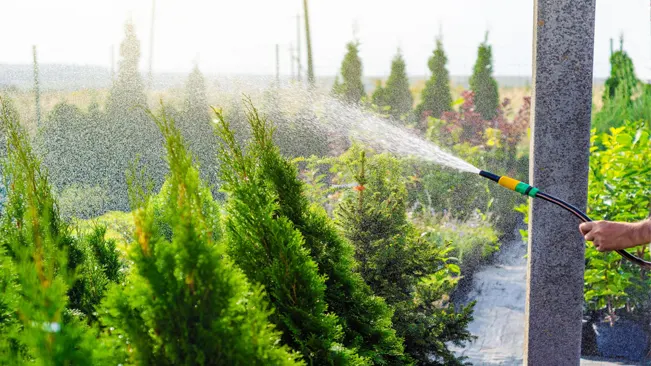
Watering Frequency
- Lemon cypress trees prefer slightly moist soil conditions. It’s crucial to strike a balance between keeping the soil consistently moist and avoiding waterlogging.
- Check the moisture level of the soil regularly, particularly during the growing season (spring and summer). Water when the top inch of soil feels dry to the touch.
- In general, lemon cypress trees typically require watering every 7-10 days, but this frequency may vary depending on factors such as climate, soil type, and container size.
Watering Technique
- When watering your lemon cypress tree, aim to thoroughly moisten the entire root ball. Water deeply to encourage root growth and penetration into the soil.
- Use a gentle watering technique to avoid disturbing the soil or compacting the root system. A soaker hose or watering can with a fine rose attachment is ideal for delivering water directly to the base of the tree.
- Avoid splashing water on the foliage, as wet foliage can increase the risk of fungal diseases.
Seasonal Adjustments
- Adjust your watering routine based on seasonal changes and weather conditions. Lemon cypress trees may require more frequent watering during hot and dry periods to prevent the soil from drying out completely.
- During cooler months or periods of dormancy, reduce the frequency of watering to prevent waterlogged soil and root rot.
Container-Grown Lemon Cypress
- If you’re growing your lemon cypress tree in a container, pay close attention to its watering needs. Potted trees may dry out more quickly than those planted in the ground, especially during warm weather.
- Ensure that your container has adequate drainage holes to allow excess water to escape freely. Always empty saucers or trays beneath the container to prevent water from pooling around the roots.
Signs of Overwatering and Underwatering
- Watch for signs of both overwatering and underwatering to adjust your watering practices accordingly.
- Symptoms of overwatering may include yellowing or wilting foliage, mushy or blackened roots, and a foul odor emanating from the soil.
- Signs of underwatering may include wilting, browning, or curling foliage, as well as dry and crumbly soil.
Fertilization
Fertilization is an important aspect of caring for lemon cypress trees to ensure they receive the nutrients necessary for healthy growth and vibrant foliage. Lemon cypress trees benefit from regular fertilization during the growing season, which typically spans from spring to early fall. During this period, the tree is actively growing and requires additional nutrients to support its development.
Choosing the Right Fertilizer
- When selecting a fertilizer for lemon cypress trees, opt for a balanced, slow-release formula specifically formulated for evergreen trees. These fertilizers are designed to provide a steady supply of nutrients over an extended period, promoting steady growth without the risk of nutrient deficiencies or excesses.
Application Method
- Follow the manufacturer’s instructions for the specific fertilizer you choose, as application rates and methods may vary. In general, apply the fertilizer evenly around the base of the tree, taking care to avoid direct contact with the trunk. Water the area thoroughly after fertilizing to help the nutrients penetrate the soil and reach the tree’s roots.
Frequency of Application
- Fertilize lemon cypress trees approximately once every 4-6 weeks during the growing season. However, it’s essential to monitor the tree’s response to fertilization and adjust the frequency as needed. Avoid over-fertilizing, as this can lead to nutrient imbalances, root damage, and stress on the tree.
Signs of Over-Fertilization
- Watch for signs of over-fertilization, such as yellowing or browning of the foliage, stunted growth, or scorched leaf tips. If you notice any of these symptoms, discontinue fertilization and flush the soil with water to help leach out excess nutrients.
Pruning and Shaping
Pruning is essential to maintain the desired shape and size of your lemon cypress tree. You can prune your tree lightly throughout the year to remove dead or damaged branches and promote healthy growth. Additionally, you can trim the tips of the branches to encourage bushier growth and maintain a compact shape. Avoid heavy pruning, as lemon cypresses do not respond well to drastic cuts.
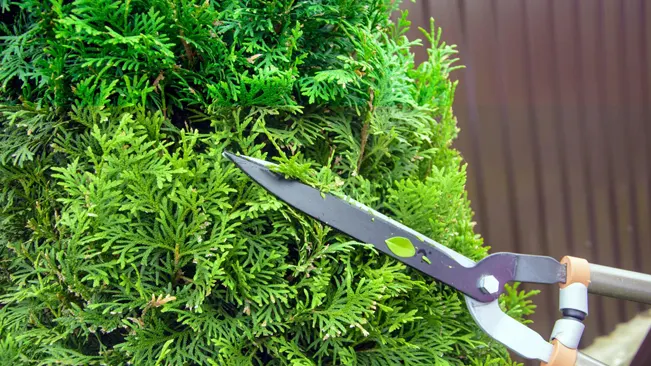
Regular Maintenance Pruning
- Conduct regular inspections of your lemon cypress tree to identify any dead, diseased, or damaged branches.
- Use sharp and clean pruning shears to carefully remove these unhealthy branches. Make clean cuts just above a healthy bud or lateral branch to promote proper healing and new growth.
Shaping for Aesthetic Purposes
- Lemon cypress trees naturally grow in a pyramidal or columnar shape. If you wish to maintain a specific shape or size, periodic shaping is necessary.
- Trim the tips of the branches to encourage branching and denser foliage. This will help your tree maintain a compact and bushy appearance.
- Start shaping your lemon cypress tree when it is young to establish the desired form gradually. Avoid heavy pruning all at once, as it can stress the tree and result in sparse growth.
Timing of Pruning
- Prune your lemon cypress tree lightly throughout the year to address immediate concerns such as damaged branches or irregular growth.
- The best time for shaping and more significant pruning is during the late winter or early spring, before the new growth emerges. This allows the tree to recover from pruning stress and produce vigorous new growth during the growing season.
Avoiding Over-Pruning
- Lemon cypress trees do not respond well to heavy or drastic pruning. Avoid removing more than one-third of the tree’s foliage at a time, as this can weaken the tree and inhibit its ability to recover.
- Maintain a balanced approach to pruning, focusing on removing only necessary branches and shaping gradually over time.
Pest and Disease Control
While lemon cypress trees are relatively resistant to pests and diseases, they may occasionally encounter issues such as aphids, spider mites, or root rot. Inspect your tree regularly for signs of infestation or disease, and take prompt action to address any problems. Insecticidal soap or neem oil can help control pests, while improving soil drainage can prevent root rot.
Pest Control
- Aphids: Aphids are small, soft-bodied insects that feed on the sap of plants, causing leaves to curl and distort. To control aphids on your lemon cypress tree, you can spray the affected foliage with insecticidal soap or a neem oil solution. These natural remedies help suffocate and repel aphids without harming beneficial insects.
- Spider Mites: Spider mites are tiny pests that suck the sap from plant leaves, causing yellowing, stippling, and webbing. To manage spider mites, regularly spray your lemon cypress tree with a strong jet of water to dislodge them from the foliage. Alternatively, you can apply insecticidal soap or neem oil to control infestations.
Disease Control
- Root Rot: Root rot is a fungal disease caused by overly wet soil conditions, leading to the decay of plant roots. To prevent root rot in your lemon cypress tree, ensure proper soil drainage by planting it in well-draining soil and avoiding overwatering. Allow the top inch of soil to dry out between waterings to prevent waterlogged conditions, which promote fungal growth.
Preventive Measures
- Regular Inspection: Regularly inspect your lemon cypress tree for signs of pest infestation or disease, such as discolored foliage, wilting, or unusual growth patterns. Early detection allows for prompt intervention, minimizing damage to the tree.
- Cultural Practices: Implement good cultural practices to promote the overall health and vigor of your lemon cypress tree. This includes proper watering, fertilization, and pruning practices tailored to the specific needs of the tree.
- Sanitation: Practice good sanitation by removing fallen leaves, debris, and dead plant material from around the base of the tree. This helps reduce potential breeding grounds for pests and pathogens, minimizing the risk of infestation or disease spread.
Winter Care
Lemon cypress trees, while hardy in USDA zones 7-10, may require additional care in colder climates to protect them from freezing temperatures. Here are some steps you can take to ensure the health and survival of your lemon cypress tree during the winter months:

- Bring Indoors or Provide Shelter: If you’re growing your lemon cypress tree in a container or pot, consider bringing it indoors during the winter months. Place it near a sunny window where it can still receive adequate sunlight. Alternatively, if your tree is planted in the ground, provide shelter by covering it with frost cloth or burlap to insulate it from cold winds and frost.
- Mulch Around the Base: Applying a layer of organic mulch around the base of the tree can help regulate soil temperature and retain moisture. Mulch acts as insulation, protecting the roots from freezing temperatures and fluctuations in soil temperature. Make sure not to pile mulch directly against the trunk to avoid potential rotting issues.
- Watering: While lemon cypress trees don’t require as much water during the winter months, it’s important to ensure that the soil doesn’t completely dry out. Water your tree sparingly, keeping the soil slightly moist but not waterlogged. Avoid watering during freezing temperatures to prevent ice formation around the roots.
- Monitor for Frost Damage: Keep an eye out for signs of frost damage, such as browning or wilting foliage. If frost damage occurs, prune affected branches once the threat of frost has passed to encourage new growth in the spring.
- Consider Microclimate: Take advantage of any natural microclimates in your garden that may provide extra warmth and protection for your lemon cypress tree. Planting near a south-facing wall or using windbreaks can help create a more favorable environment for your tree during the winter months.
Container Care
If you’ve chosen to grow your lemon cypress tree in a container, there are a few key considerations to keep in mind to ensure its health and vitality.
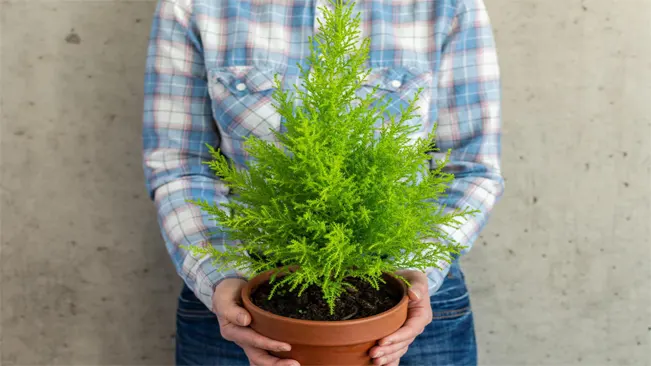
- Drainage
- Proper drainage is essential for container-grown lemon cypress trees. Make sure your container has adequate drainage holes at the bottom to allow excess water to escape. This prevents waterlogged soil, which can lead to root rot and other issues.
- Root Space
- Lemon cypress trees have an extensive root system, so it’s important to provide them with enough room to grow. Choose a container that is slightly larger than the root ball of your tree when planting. As the tree grows, you may need to repot it into a slightly larger container every couple of years to prevent it from becoming root-bound.
- Soil Moisture
- Container-grown lemon cypress trees require more frequent watering compared to those planted in the ground, as containers tend to dry out faster. Monitor the moisture levels of the soil regularly, especially during hot or dry weather. Water thoroughly when the top inch of soil feels dry to the touch, but be careful not to overwater, as this can lead to root rot.
- Fertilization
- Fertilize container-grown lemon cypress trees regularly during the growing season (spring and summer) to provide them with essential nutrients. Use a balanced, slow-release fertilizer specifically formulated for container plants, following the manufacturer’s instructions for application rates.
- Light and Temperature
- Place your container-grown lemon cypress tree in a location that receives full sunlight for at least 6-8 hours per day. Indoors, position the tree near a south-facing window to ensure it gets enough sunlight. Lemon cypress trees are hardy in USDA zones 7-10, so if you live in a colder climate, bring the container indoors before the first frost or provide winter protection.
Conclusion
By following these tips and techniques, you can successfully grow and care for a lemon cypress tree, adding a touch of freshness and elegance to your garden or indoor space. With proper attention to watering, fertilization, pruning, and pest control, your lemon cypress will thrive and bring joy for years to come. Happy gardening!
FAQs (Frequently Asked Questions)
- What is a Lemon Cypress Tree?
- A Lemon Cypress Tree, scientifically known as Cupressus macrocarpa ‘Goldcrest’, is a cultivar of the Monterey cypress. It is characterized by its vibrant yellow-green foliage and lemon-scented needles.
- A Lemon Cypress Tree, scientifically known as Cupressus macrocarpa ‘Goldcrest’, is a cultivar of the Monterey cypress. It is characterized by its vibrant yellow-green foliage and lemon-scented needles.
- Where Should I Plant My Lemon Cypress Tree?
- Lemon Cypress Trees thrive in well-draining soil and full sunlight. Choose a location in your garden or on your patio that receives at least 6-8 hours of sunlight daily.
- Lemon Cypress Trees thrive in well-draining soil and full sunlight. Choose a location in your garden or on your patio that receives at least 6-8 hours of sunlight daily.
- How Often Should I Water My Lemon Cypress Tree?
- Lemon Cypress Trees prefer slightly moist soil. Water thoroughly when the top inch of soil feels dry to the touch, typically every 7-10 days. Ensure proper drainage to prevent waterlogged roots.
- Lemon Cypress Trees prefer slightly moist soil. Water thoroughly when the top inch of soil feels dry to the touch, typically every 7-10 days. Ensure proper drainage to prevent waterlogged roots.
- Do Lemon Cypress Trees Require Fertilization?
- Yes, lemon cypress trees benefit from regular fertilization during the growing season (spring and summer). Use a balanced, slow-release fertilizer specifically formulated for evergreen trees.
- Yes, lemon cypress trees benefit from regular fertilization during the growing season (spring and summer). Use a balanced, slow-release fertilizer specifically formulated for evergreen trees.
- How Can I Prune My Lemon Cypress Tree?
- Pruning lemon cypress trees is not necessary for their health but can be done for shaping purposes. Use sharp pruning shears to remove dead or damaged branches and to maintain the desired shape.
- Pruning lemon cypress trees is not necessary for their health but can be done for shaping purposes. Use sharp pruning shears to remove dead or damaged branches and to maintain the desired shape.
- What Pests Should I Watch Out For?
- Lemon Cypress Trees are generally resistant to pests, but occasional infestations of aphids, spider mites, or scale insects may occur. Monitor your tree regularly and treat infestations with insecticidal soap or neem oil.
- Lemon Cypress Trees are generally resistant to pests, but occasional infestations of aphids, spider mites, or scale insects may occur. Monitor your tree regularly and treat infestations with insecticidal soap or neem oil.
- Can Lemon Cypress Trees Be Grown Indoors?
- Yes, lemon cypress trees can be grown indoors as long as they receive adequate sunlight. Place your tree near a south-facing window where it can get direct sunlight for several hours each day.
- Yes, lemon cypress trees can be grown indoors as long as they receive adequate sunlight. Place your tree near a south-facing window where it can get direct sunlight for several hours each day.
- Do Lemon Cypress Trees Require Winter Protection?
- Lemon Cypress Trees are hardy in USDA zones 7-10 and can withstand mild winter temperatures. However, if you live in a colder climate, consider bringing potted lemon cypress trees indoors or providing winter protection such as mulch or burlap wraps.
- Lemon Cypress Trees are hardy in USDA zones 7-10 and can withstand mild winter temperatures. However, if you live in a colder climate, consider bringing potted lemon cypress trees indoors or providing winter protection such as mulch or burlap wraps.
- How Big Will My Lemon Cypress Tree Grow?
- Lemon Cypress Trees typically grow to a height of 6-8 feet when planted in the ground. However, they can be pruned to maintain a smaller size, making them suitable for containers and small gardens.
- Lemon Cypress Trees typically grow to a height of 6-8 feet when planted in the ground. However, they can be pruned to maintain a smaller size, making them suitable for containers and small gardens.
- Are Lemon Cypress Trees Toxic to Pets?
- Lemon Cypress Trees are not considered toxic to cats or dogs. However, ingestion may cause mild gastrointestinal upset, so it’s best to keep pets from nibbling on the foliage.
For more expert gardening and advice, explore our guides, discover top recommendations in our best section, and delve into in-depth product reviews in our review section. Happy Gardening.

Kristine Moore
Forestry AuthorI'm Kristine Moore, a seasoned garden landscaping professional with over 30 years of experience. My extensive career has been dedicated to transforming outdoor spaces into stunning, sustainable landscapes. With a deep understanding of horticulture, design principles, and environmental stewardship, I have become a respected figure in the field, known for creating harmonious, visually appealing, and eco-friendly gardens. My commitment to excellence and continuous learning in landscaping trends and techniques has solidified my reputation as an expert in garden design and implementation.













Leave your comment